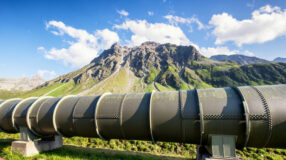Members of the Interstate Natural Gas Association of America are taking concrete steps to reduce methane emissions from their systems and have made commitments to find ways to curb releases even further.
To better understand the issue, several INGAA members participated in a joint industry-environmental group study, led by researchers at Colorado State University, to investigate the level of methane emissions from the transmission and storage sector that delivers natural gas across the nation for power generation, manufacturing, and to retail distributors which deliver it to homes and businesses.
This study was sponsored by the Environmental Defense Fund, Dominion, Dow Chemical, Enable Gas Transmission Company, Kinder Morgan, Columbia Pipeline Group, TransCanada and Williams. INGAA also participated in the study.
Parallel studies are being conducted of methane releases across other segments of the nation’s natural gas production and delivery system.
The study, released today in the journal of Environmental Science & Technology, involved researchers from CSU, Carnegie Mellon University and Aerodyne Research taking measurements of methane emissions at 45 transmission and storage facilities throughout the country. This is the most comprehensive on-site study conducted to date on these types of facilities. A second study will use this data to build a model of nationwide estimates from this sector, which can be compared with Environmental Protection Agency greenhouse gas estimates. This study will be released in the coming months.
The newly released study indicated that a few sites accounted for the majority of the measured emissions. At the 45 sites researchers sampled, just two sites accounted for almost as much methane as the other 43 sites combined. The higher emissions at the two sites were likely due to a faulty valve.
“This finding indicates a need to focus methane management measures on sites and equipment with the highest emissions profile,” said INGAA President and CEO Don Santa. “It’s also very consistent with the direction INGAA members are voluntarily taking to reduce emissions.”
Santa explained that last summer, INGAA members committed to develop industry guidelines for Directed Inspection and Maintenance of natural gas pipeline facilities. DI&M is a well-established and EPA-recognized tool for detecting and mitigating leaks in a cost-effective manner. While most INGAA member pipeline companies use DI&M, the guidelines will improve consistency and uniformity, which should result in further emissions reductions and help focus efforts on reducing emissions from the pipeline equipment that has the potential to release the most methane. INGAA also is working with research groups to create a roadmap for developing technological innovations to make DI&M even more effective.
The CSU-led study also identifies sources of emissions from natural gas transmission and storage that are under-reported in or excluded from another EPA emissions measurement program, called the EPA’s Greenhouse Gas Reporting Program. Emissions reported in this study were higher than the emissions level reported in the GHGRP because the GHGRP excludes many sources and its reporting methods can under-estimate emissions. INGAA comments during GHGRP development point out some of these deficiencies.
“This finding isn’t surprising,” Santa said. “The GHGRP only covers a small portion of the nation’s natural gas compressor facilities. Under EPA reporting rules, only those facilities with emissions of 25,000-metric-ton carbon dioxide equivalent submit emissions data to EPA. In addition, some facility sources of methane measured for this new study are not included in the GHGRP, such as compressor and valve-related leaks in certain operating modes.”
INGAA members have made great strides already in reducing methane releases through the use of new technology and improved pipeline integrity and maintenance programs. The natural gas transmission industry reduced the number of leaks along the pipe by 94 percent, preventing 122 million metric tons of CO2-equivalent emissions over the past three decades. These prevented emissions are equivalent to removing more than 25 million passenger vehicles from the road for one year.







